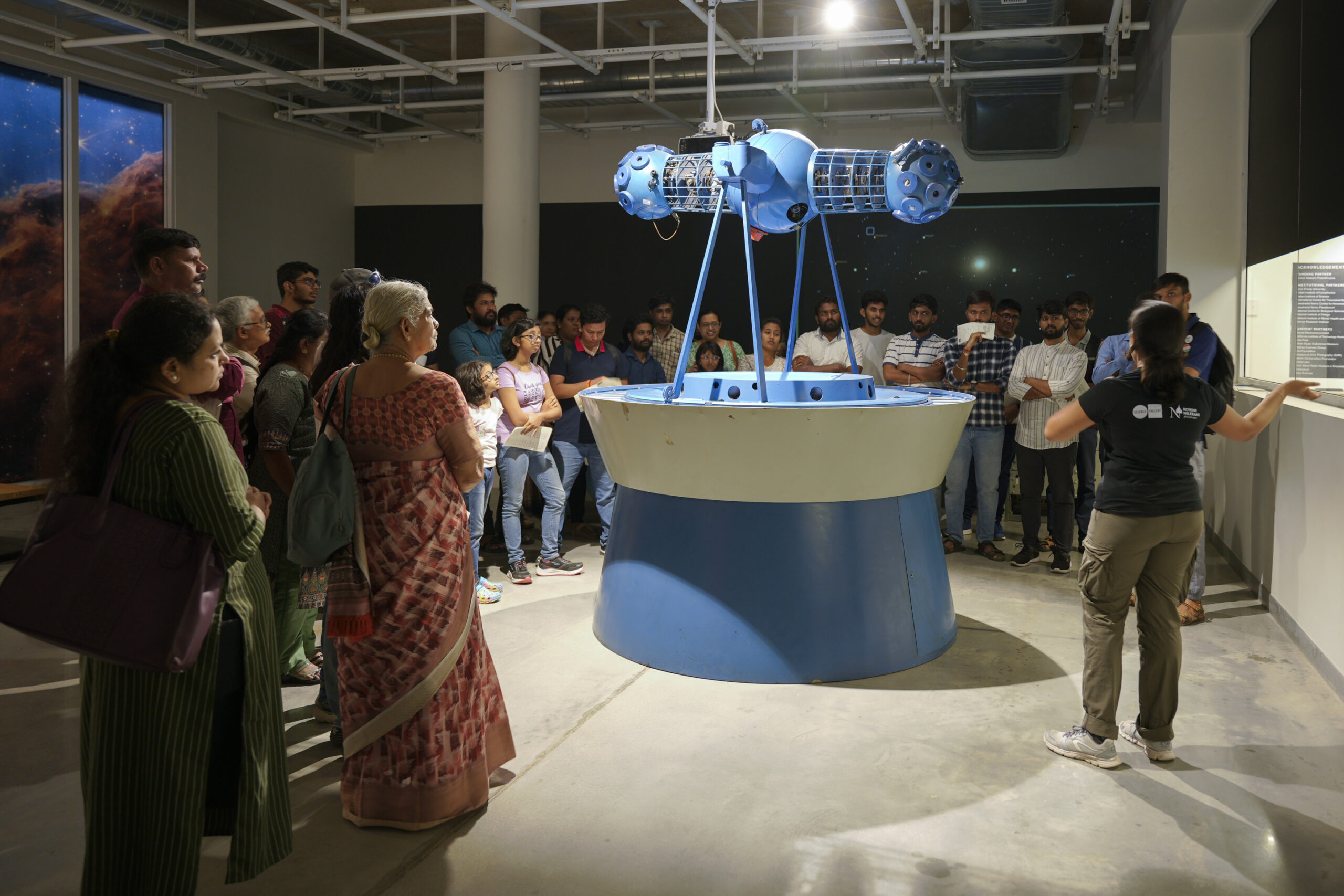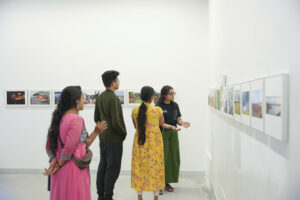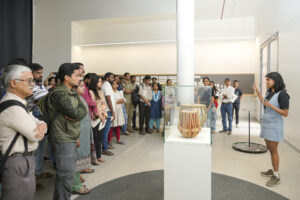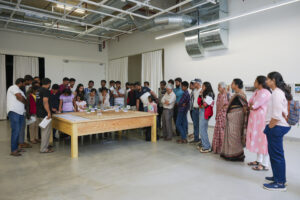Bengaluru's legacy is captured through a series of exhibits that highlight its contributions to science, technology, and the arts.
Published Sep 01, 2024 | 9:00 AM ⚊ Updated Sep 02, 2024 | 2:05 PM

The Planetarium Projector. (Supplied)
In 1962, Jawaharlal Nehru remarked, “Most of the other cities of India remind one certainly of the present, certainly of the future but essentially of the past. But Bangalore, more than any other great city of India, is a picture of the future.”
Today, his words resonate deeply with the unveiling of Sci560 at the Science Gallery Bengaluru (SGB), an exhibition encapsulating Bengaluru’s enduring spirit of innovation and its role as a beacon of scientific progress in India.
Running until December 2024, this exhibition is a must-visit for anyone eager to explore Bengaluru’s rich science, technology, and innovation history.
It features 30 diverse exhibits, each bringing different facets of science and technology to life, making it a significant cultural and educational landmark.
Sci560 is more than just an exhibition; it’s a narrative that weaves together Bengaluru’s past, present, and future in the realms of science and technology.

Bangalore Torpedo, a device used to clear obstacles during wartime. (Supplied)
The exhibition’s name, a fusion of Bengaluru’s postal code prefix ‘560’ with ‘Sci’ for science, symbolises the city’s pivotal role in India’s scientific landscape.
The exhibition is the result of collaboration between 10 city-wide institutions and SGB, with generous support from Rohini Nilekani Philanthropies.
The exhibits cover a wide range of topics, from fundamental research to applied sciences, and are carefully curated to reflect Bengaluru’s contributions to various scientific fields.
Among the highlights are the Kolar Gold Fields neutrino experiments, the Bheja Fry exhibit that explores how the brain codes time, and the famous Bangalore Torpedo developed by the Madras Engineer Group.
Each exhibit tells a unique story, contributing to the overarching theme of how Bengaluru has shaped, and been shaped by scientific advancements.
One of the standout exhibits, for instance, explores the relationship between technology and human behaviour, challenging visitors to reflect on how innovations are reshaping societal norms. Another delves into the environmental impact of urbanisation, a particularly pertinent topic in a city like Bengaluru, where rapid growth often comes at the cost of its natural heritage.
The Hindustan Trainer-2 (HT-2), designed and built by Hindustan Aeronautics Limited (HAL) in 1951, stands as a testament to India’s nascent aerospace industry.

HT-2 was India’s first domestically designed aircraft. (Deeksha Devadiga/South First)
Developed under Vishnu Madav Ghatage, the HT-2 was India’s first domestically designed aircraft. This two-seat military trainer served the Indian Air Force for nearly 30 years, symbolising the collaboration between industry, science, and the military.
The exhibit features early photographs, a caricature by BV Ramamurthy, and a watercolour painting of the HT-2 in flight, highlighting Bengaluru’s pivotal role in India’s aerospace journey.
In the early 20th century, Nobel laureate CV Raman explored the physics of sound using Indian percussion instruments, particularly the tabla and mridangam. Unlike Western percussion instruments, these Indian drums produce complex harmonic frequencies, revealing insights into sound vibrations.
Raman’s research, conducted before his work on optics, showcased how these instruments could generate different pitches, known as harmonic frequencies, which intrigued and informed his later scientific discoveries.
At the exhibition, visitors can marvel at a tabla donated by the Raman Research Institute and interact with Chladni plates that visualise sound vibrations through intricate sand patterns. These exhibits illuminate Raman’s groundbreaking work and the profound complexity of sound produced by traditional Indian instruments.
The Kere Chronicles photo series captures the efforts to restore Bengaluru’s once-thriving lakes, like Hesaraghatta and Hebbal-Nagawara Valley.

Kere Chronicles photo series. (Supplied)
The series highlights the contrast between destruction and revival, documenting the impact of encroachment and the community’s dedication to preserving these vital ecosystems. The photographs underscore the interconnectedness of natural landscapes and urban life.
The Electronic Voting Machine (EVM), piloted in 1982, has become crucial for ensuring fair elections in India. This exhibit features an old ballot box alongside modern EVMs and a Voter Verifiable Paper Audit Trail (VVPAT) machine, illustrating the evolution of voting technology.
The display highlights Bengaluru’s role in advancing democratic processes through technological innovation.
What sets Sci560 apart from a typical exhibition is the presence of mediators—young adults who guide visitors through the exhibits, making complex scientific concepts accessible and engaging.

Mediators guide visitors through the exhibits. (Supplied)
Their role goes beyond mere explanation. They encourage visitors to think critically about the exhibits and their implications for the future.
Their contributions are invaluable, transforming abstract concepts into accessible narratives. Through them, the exhibition becomes not just a display but a dialogue, inviting visitors to explore, question, and understand the scientific endeavours that shape our world.
The community aspect of Sci560 is further emphasised by the contributions of various institutions and individuals who provided objects and stories for the exhibition.
Institutions like the Indian Institute of Science, Bharat Electronics Limited, and the National Centre for Biological Sciences have all contributed significant exhibits, each representing a chapter in Bengaluru’s scientific history.
These contributions ensure that Sci560 is not just an exhibition, but a collaborative effort that reflects the collective memory and achievements of the city.
Sci560 is not a static exhibition; it is designed to evolve through ongoing public engagement. Every weekend, SGB hosts various programmes, including quizzes, guided walkthroughs, and public lectures, all aimed at deepening visitors’ understanding of the exhibits and their significance.

Exhibition is designed to evolve through public engagement. (Supplied)
The exhibition also encourages visitors to contribute their own stories and objects, potentially refreshing the content and adding new dimensions to the narrative.
Jhanavi Phalkey, the Founding Director of Science Gallery Bengaluru, emphasised the importance of this dynamic approach.
“This exhibition is as much about the city as it is about science. We want to provoke conversations and bring to the forefront the layered history of Bengaluru’s scientific journey. Sci560 is just the beginning—we hope to continue this dialogue in various forms, whether through future exhibitions, publications or even a dedicated Bengaluru museum,” Phalkey told South First.
Sci560 is a celebration of Bengaluru’s scientific spirit. It is an invitation to explore the city’s rich past, engage with its present, and imagine its future.
Whether you are a scientist, historian, or simply a curious citizen, Sci560 offers something for everyone—a chance to rediscover Bengaluru through the lens of science and innovation.
The significance of Sci560 lies not only in the knowledge it imparts but in the connections it fosters—between people and science, between past achievements and future possibilities.
In doing so, it reaffirms Nehru’s vision of Bengaluru as a city always looking forward, always embracing the future.
(Edited by Majnu Babu)
(South First is now on WhatsApp and Telegram)
